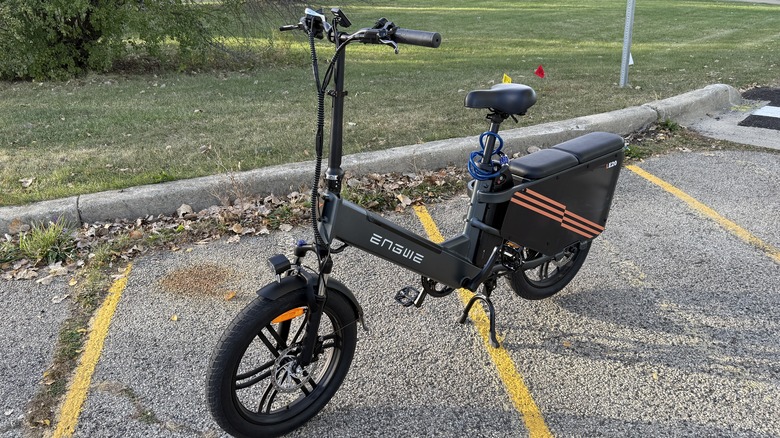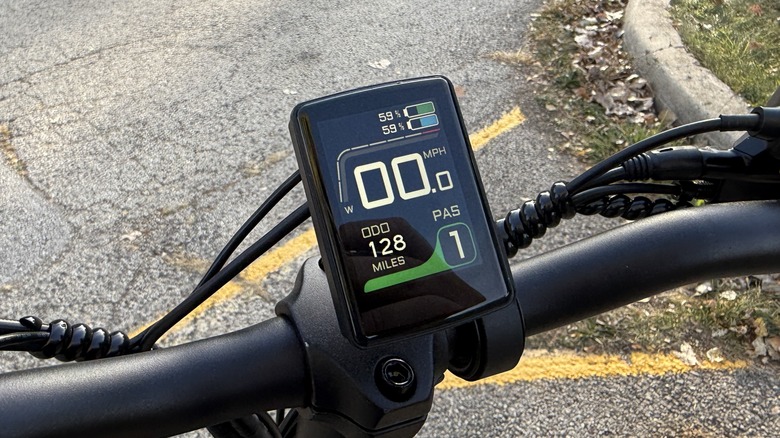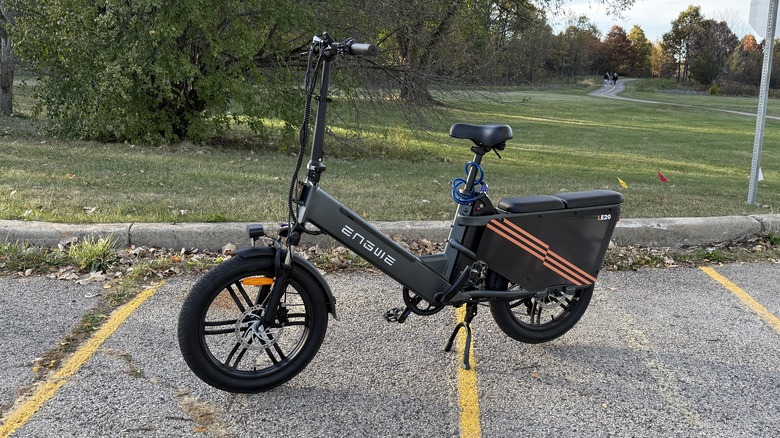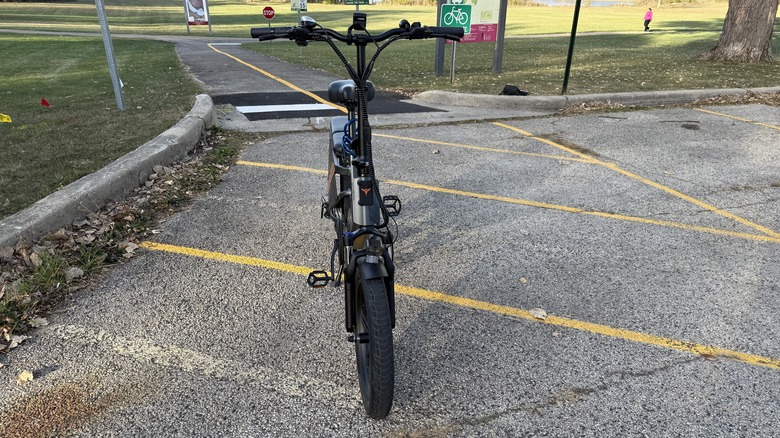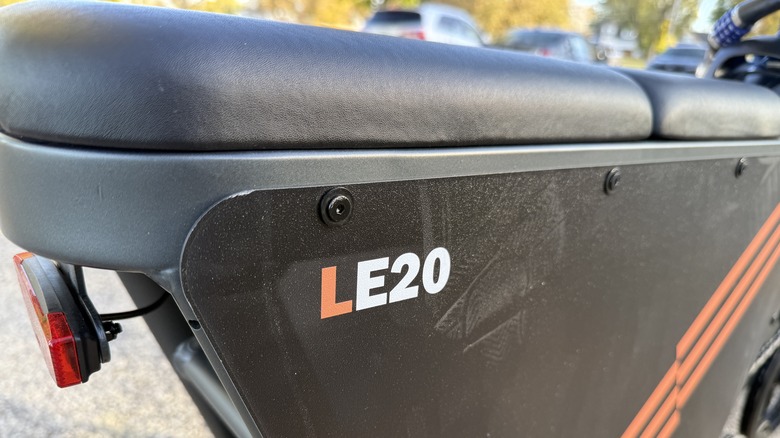This E-Bike Fixes A Big Problem, But Causes An Even Bigger Headache
In the world of e-bikes, there are some claims that can be very exaggerated. Much like EVs, the range estimates on an e-bike can be surprisingly optimistic compared to real world testing. In the e-bikes I've personally tested, I have found range estimates to end up being around half of what most manufacturers claim.
There are a number of reasons for this — terrain, environmental conditions, and the fact that I'm on the wrong side of 300 pounds are all factors. My neighborhood in particular is quite hilly. I don't live in a mountain state or anything, but there is a definite grade on the streets around my house. An average cyclist can easily climb the hills of course, but that same terrain can unfortunately tax an e-bike motor more than a well-defined set of legs.
I have been surprised coming home from a Target run on an e-bike when suddenly, the bike just up and dies, and I'm forced to pedal the rest of the way home. Typically, I have found 10 miles is about the limit I can trust an e-bike, and in my neighborhood, almost everything is a five-mile round trip, so I have to charge constantly.
That is until recently. I found a bike with range that can rival some EVs so I was very interested in the idea. I also found that can cause another problem that I thought I'd anticipated, but it turns out, not nearly enough.
Remarkable range
I started my quest to find an e-bike with a 200-mile range since I accidentally stumbled across one while researching other things about six months ago. Since then, I have been obsessed with finding one that was available in the U.S. and that seems to have been the biggest hurdle. Overseas, bikes like this are far more common, but they haven't caught on in the U.S. I checked every major e-bike brand I could think of.
When Engwe offered to send over its LE20 dual-battery cargo bike, I jumped at the opportunity. I've been riding that bike for just over a month because I wanted to try to confirm the range estimates. Unfortunately, the problem with testing a bike with a 200-mile range estimate is that you have to ride it for 400 miles to discharge it at least twice.
As it turns out, the range is closer to 100 miles. I tested it the first time by using the throttle only, and that got me around 60 miles. The second time I tested it, using a combination of pedal assist and some throttle. Between myself and my children testing it (see the aforementioned 300-pound reference), this time we got it to around 100 miles before the batteries dropped to 0% and 25% respectively. Overall, not bad, but the bike is problematic for other reasons.
Two problems
The bike itself, fully loaded with both batteries installed, weighs around 100 pounds. That is heavy for any bike, let alone an e-bike. For reference, most of the bike racks sold by Thule, which is a highly respected name in the industry, max out at 60 pounds per bike. Put simply, if you want to take the Engwe LE20 anywhere, you're probably going to have to ride it there — the good news is you can.
The bike is a very easy ride, the seat is comfortable, and the configuration that was sent to me even has a second seat for a passenger which is a nice add-on. The bike has a total load capacity of 450 pounds, which would be nice for grocery shopping runs. Plus, the bike is versatile — there are no fewer than 10 different racks, baskets, and bags you can attach to the back of this bike so you can just haul stuff around. Add in a digital display and turn signals, and you get a complete package.
The batteries themselves are both removable, which is nice, but each one takes around 6-8 hours to charge fully. The charger also gets pretty toasty when plugged in. Engwe said the battery charger should not exceed 60 degrees Celsius (around 140 degrees Fahrenheit) and to be fair, it probably doesn't, but even 140 degrees is pretty hot.
Great to ride
One of my favorite parts about the bike is the choice between throttle or pedal assist. The Throttle maxes out at 20 mph, which is a little disappointing — it's not the fastest e-bike you can buy, but it's still not bad. Getting 60 miles using just the throttle is pretty great.
When using pedal assist, there are five levels of it, but it's so good I never felt the need to go beyond Level 3 (and I spent most of my time in Level 1). The pedal assist has a torque sensor, which is, in my humble opinion, much preferable to a cadence sensor. The difference between the two is a torque sensor doesn't kick in until you're expelling effort in the pedals and even then, it will only give enough assistance you keep you going at a nice pace. A cadence sensor kicks in as soon as you rotate the pedals even slightly and most of the time it's an all-or-nothing proposition. You're either going full speed, or you're pedaling manually.
The bike rides a little low. When I ride it, I need to make sure the pedal on the side that I'm turning into is up or I frequently scrape the pavement. As a result, the kickstand can ride a bit low as well, but that's my only real gripe here. Everything about the bike is super smooth and I'm in love with it.
It's pretty cheap too
As far as e-bikes go, this one is not too expensive. It normally retails for $1,499, but as of this writing (and I believe through Black Friday) it's on sale for $1,249. Most of Engwe's bikes are seasonally discounted, and the company has a few other promotions running you can check out on their Black Friday page.
Overall, it's fairly inexpensive, a very nice ride, and the range is very good. I'm not fond of how long it takes to charge, and I'm definitely not fond about the weight, but all the same, it's great having an e-bike I can use for my errands around town, save some money on gas, and not have to charge more than once a week — and even that is only if I'm having a really busy week.
Am I trading one problem for another? That may be, but the weight is more manageable considering the range. It's a trade-off I'd happily make. Weight tends to be a problem with e-bikes. The lightest ones you can find are usually in the 40-pound range, so honestly, this isn't bad. You just have to decide what your priorities are, and in my book, weight is a tradeoff I'll happily accept.
